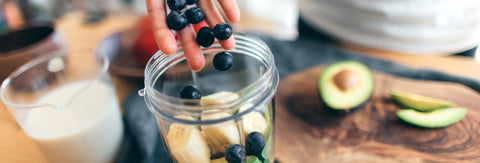When you imagine an elite female athlete getting ready for her day, would you imagine her skipping breakfast? Grabbing her kids toast crusts? Or winging her lunch all together as she runs out the door?
One of the most common reasons women seek medical attention is their fatigue and changes to body composition and weight and yet the overall makeup of a woman’s nutrition can easily be an afterthought or a series of heroic attempts at controlling her food intake with the hopes of change. Even though we recognize that the female athlete would need to fuel herself for her day, many women don’t focus on this important area of health. With the popularity of fasting and various eating regimes for conditions like type 2 diabetes, many women may believe that restrictive eating patterns are also beneficial for her health. General research points towards women having more hunger and more fatigue when they adopt fasting protocols when they aren’t needed for an underlying health condition1.
Lean muscle tissue is a woman’s metabolically active tissue in her body. Muscle tissue begins to decline with age for many reasons, including women performing less exercise and the impact that aging has on the ability to use dietary protein to grow muscle2. As women age, their needs for protein in their diet increase over time to help preserve her lean tissue into her fifth to seventh decade. Women require 1.2-1.5 grams of protein per day per kilogram of her body weight to try and combat the age related decline in muscle that happens after age 303. When women don’t fuel their muscle through nutrition, they have more rapid loss of lean tissue with age, and a lowering of her metabolic rate4. This creates a viscous cycle of losing muscle while gaining adipose tissue. This causes her metabolic rate to decline and she may begin to gain weight with the same diet she’s always eaten.
When women learn to fuel for performance for her day, we witness improvements in energy and overall satiety, meaning that she is energized and full from her meals5. Haphazard eating and chronic dieting has negative impacts on a woman’s metabolic rate and hormones which can leave her feeling less like herself. Women with PMS have an improvement in their symptoms when they are intentionally given carbohydrates during the luteal phase6,7 and women who replace simple carbohydrates with more complex carbohydrates have an improvement in their PMS symptoms8. Women in menopause report more hot flashes in long stretches between meals when blood sugar falls9 and have less hot flashes when their nutrition includes a variety of vitamins, antioxidants and omega-3 fats10,11.
Focusing on nutrition and fuelling for the day can help women feel better energy and reduce her hormonal symptoms including PMS and menopause. If fatigue is one of your primary concerns, checking in on overall nutrition status can be a first step towards understanding the impact of nutrition on energy, mood and hormonal symptoms.
- Harvie, M. & Howell, A. Potential Benefits and Harms of Intermittent Energy Restriction and Intermittent Fasting Amongst Obese, Overweight and Normal Weight Subjects—A Narrative Review of Human and Animal Evidence. Behav. Sci. 7, (2017).
- Xie, W.-Q. et al. Caloric restriction: implications for sarcopenia and potential mechanisms. Aging 12, 24441–24452 (2020).
- Deutz, N. E. P. et al. Protein intake and exercise for optimal muscle function with aging: recommendations from the ESPEN Expert Group. Clin. Nutr. Edinb. Scotl. 33, 929–936 (2014).
- Cruz-Jentoft, A. J. et al. Sarcopenia: revised European consensus on definition and diagnosis. Age Ageing 48, 16–31 (2019).
- Veldhorst, M. et al. Protein-induced satiety: effects and mechanisms of different proteins. Physiol. Behav. 94, 300–307 (2008).
- Wurtman, J. J., Brzezinski, A., Wurtman, R. J. & Laferrere, B. Effect of nutrient intake on premenstrual depression. Am. J. Obstet. Gynecol. 161, 1228–1234 (1989).
- Sayegh, R. et al. The effect of a carbohydrate-rich beverage on mood, appetite, and cognitive function in women with premenstrual syndrome. Obstet. Gynecol. 86, 520–528 (1995).
- Esmaeilpour, M., Ghasemian, S. & Alizadeh, M. Diets enriched with whole grains reduce premenstrual syndrome scores in nurses: an open-label parallel randomised controlled trial. Br. J. Nutr. 121, 992–1001 (2019).
- Dormire, S. & Howharn, C. The Effect of Dietary Intake on Hot Flashes in Menopausal Women. J. Obstet. Gynecol. Neonatal Nurs. JOGNN NAACOG 36, 255–262 (2007).
- Odai, T. et al. Severity of hot flushes is inversely associated with dietary intake of vitamin B6 and oily fish. Climacteric J. Int. Menopause Soc. 22, 617–621 (2019).
- Abshirini, M. et al. Dietary total antioxidant capacity is inversely related to menopausal symptoms: a cross-sectional study among Iranian postmenopausal women. Nutr. Burbank Los Angel. Cty. Calif 55–56, 161–167 (2018).




